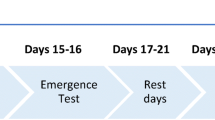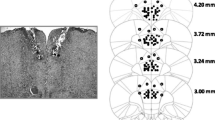Abstract
Studies with electrical brain stimulation suggest that the dorsal periaqueductal grey matter (DPAG) is related to anxiety and to the anti-aversive effects of benzodiazepines (BZD) compounds. However, direct stimulation of the brain may prevent conclusions about the role of specific regions in the control of normal behaviour. In the present study we employed the elevated plus-maze, an ethologically based model of anxiety, to investigate the role of BZD receptors located in the DPAG in anxiety and in the anxiolytic effect of systemically injected BZD. The results showed that midazolam (20–80 nmol), a BZD agonist, dose-dependently increased the percentage of entries and time spent in open arms when microinjected into the DPAG. The effect of midazolam (80 nmol) was antagonized by flumazenil (80 nmol), a BZD antagonist, microinjected into the DPAG 10 min before the agonist. FG 7142 (20–80 nmol), a BZD partial inverse agonist, decreased time spent in open arms at the dose of 40 nmol and the number of open arms entries at all doses when microinjected into the DPAG. The microinjection of flumazenil (80 nmol) into the DPAG failed to antagonize the anxiolytic effect of systemically injected diazepam (2.5 mg/kg). These results strengthen the idea of an involvement of BZD receptors located in the DPAG with anxiety. They also suggest that the DPAG is not the only structure responsible for the anxiolytic effects of systemically injected BZD.
Similar content being viewed by others
References
Audi EA, Graeff FG (1984) Benzodiazepine receptors in the periaqueductal grey mediate anti-aversive drug action. Eur J Pharmacol 103:279–285
Brandão ML, Aguiar JC, Graeff FG (1982) GABA mediation of antiaversive action of minor tranquilizers. Pharmacol Biochem Behav 16:397–402
Delgado JMR, Roberts WW, Miller NE (1954) Learning motivated by electrical stimulation of the brain. Am J Physiol 179:587–593
Di Scala G, Mana MJ, Jacobs WJ, Phillips AG (1987) Evidence of Pavlovian conditioned fear following electrical stimulation of the periaqueductal grey in the rat. Physiol Behav 40:55–63
Dorow R, Horowski R, Paschelke G, Amim M, Braestrup C (1983) Severe anxiety induced by FG 7142, aβ-carboline for benzodiazepine receptors. Lancet 9:98–99
File SE, Pellow S (1985) The anxiogenic action of FG 7142 in the social interaction test is reversed by chlordiazepoxide and RO-1788 but not by CGS 8216. Arch Int Pharmacodyn Ther 271:198–205
Graeff FG (1990) Brain defense system and anxiety. In: Roth M, Burrows GD, Noyes R (eds) Handbook of anxiety, vol 3. Elsevier, Amsterdam, pp 307–354
Graeff FG, Brandão ML, Audi EA, Schütz MTB (1986) Modulation of the brain aversive system by GABAergic and serotonergic mechanisms. Behav Brain Res 21:65–72
Guimarães FS, Carobrez AP, De Aguiar JC, Graeff FG (1991) Anxiolytic effect in the elevated plus-maze of the NMDA receptor antagonist AP7 microinjected into the dorsal periaqueductal grey. Psychopharmacology 103:91–94
Hodges H, Green S, Glenn B (1987) Evidence that the amygdala is involved in benzodiazepine and serotonergic effects on punished responding but not on discrimination. Psychopharmacology 92:491–504
König JFR, Klippel RA (1963) The rat brain in stereotaxic coordinates. Williams and Wilkins, Baltimore
Lister RG (1990) Ethologically-based animal models of anxiety disorders. Pharmacol Ther 46:321–340
Milani H, Graeff FG (1987) GABA-benzodiazepine modulation of aversion in the medial hypothalamus of the rat. Pharmacol Biochem Behav 28:21–27
Nashold Jr BS, Wilson NP, Slaughter GS (1969) Sensations evoked by stimulation in the midbrain of man. J Neurosurg 30:14–24
Olds ME, Olds J (1962) Approach-escape interactions in rat brain. Am J Physiol 203:803–810
Pellow S, File SE (1986) Anxiolytic and anxiogenic effects on exploratory activity in an elevated plus-maze. A novel test of anxiety in the rat. Pharmacol Biochem Behav 24:525–529
Pellow S, Chopin P, File SE, Briley M (1985) Validation of open: closed arm entries in an elevated plus-maze as a measure of anxiety in the rat. J Neurosci Methods 14:149–167
Richards JG, Schoch P, Möhler H, Haefely W (1986) Benzodiazepine receptors resolved. Experientia 42:121–126
Roberts VJ, Cox VC (1987) Active avoidance conditioning with dorsal central gray stimulation in a place preference paradigm. Psychobiology 15:167–170
Shibata K, Kataoka Y, Gomita Y, Ueki S (1982) Localization of the site of the anticonflict action of benzodiazepines in the amygdaloid nucleus of rats. Brain Res 234:442–446
Zorumski CF, Isenberg KE (1991) Insights into the structure and function of GABA-benzodiazepine receptors: ion channels and psychiatry. Am J Psychiatry 148:162–173
Author information
Authors and Affiliations
Rights and permissions
About this article
Cite this article
Russo, A.S., Guimarães, F.S., De Aguiar, J.C. et al. Role of benzodiazepine receptors located in the dorsal periaqueductal grey of rats in anxiety. Psychopharmacology 110, 198–202 (1993). https://doi.org/10.1007/BF02246973
Received:
Revised:
Issue Date:
DOI: https://doi.org/10.1007/BF02246973




